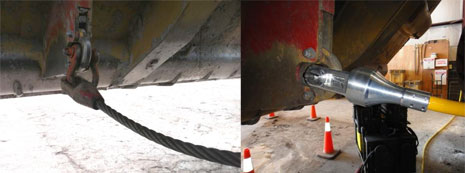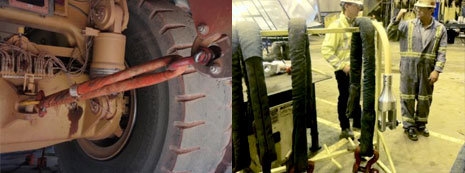ADVANTAGES OVER STEEL WIRE / CABLE

The handling weight of steel wire tie-backs and hardware are recognized as industry-wide safety hazard. The average 23T/1.5” steel tie-back weighs 90 lbs, and when coupled with 29lb shackle, weighs 119lbs, typically requiring a 2 person installation. The sheer weight requires many cables be left on the body, which dramatically increases lifecycle cost and introduces the potential for damaged, unsafe wires. The Applied Fiber tie-back eliminates the need to leave cables on the body by addressing weight (3X lighter) and nearly every other ergonomic drawback of steel wire tie-backs – as outlined below:
HANDLING SAFETY / INJURY PREVENTION
- Reduced Handling Weight and Strains: Typical 3X weight savings dramatically reduces injury potential.
- Lower Crushing/Dropping Weight: Less drops due to less hardware and less weight.
- No Cable Torsion /Twist Fighting: Stiff steel wires often get twisted in non-ideal positions, and require the user to force them back with each installation. Applied Fiber tie-backs have permanent memory and are easily positioned without tools or straining.
- No Kinking & Misalignment Fighting: Stiff steel wires kink easily and once bent, are difficult to align do to the cable’s inherent stiffness. Applied Fiber tie-backs don’t kink and are highly flexible making installations easy.
- No Broken Wire “Fish-Hooks” / ”Jaggers”: Any broken wires creates a signifant safety hazard. Applied Fiber tie-backs have no such wires.
- No Shackle Weight to Elevate and Maneuver: Shackle weight and installation process alone introduces a safety hazard, especially when elevated. The Applied Fiber tie-back eliminates the need for shackles.
- No Pins/Wrenches/Shackles to Handle or Drop at Elevation: Applied Fiber’s ergonomic pin system is fully self contained. No tools are needed and no hardware can fall off during an elevated installation.
- Reduced Pinch Points and Crush Weights: Creating single operator installation, reducing system weight, and eliminating shackles and other hardware significantly reduces potential for pinches and crushing during installation.
- Improved Field Use with Single Operator: Applied Fiber tie-backs are easily transported, require no additional hardware, have no parts to lose, and are safely installed by one person, making them ideal for emergency field repairs.
- Reduced Potential for Improper Use: No “wrong shackle” or “wrong hardware” to pull, and reduced chance of cable damage that is common with truck body field wear.
OTHER FINANCIAL SAVINGS:
- Longer Lifespan through Truck Body Removal: If cables are currently left on the bed, the Applied Fiber system will produce significant cost savings from longevity alone.
- Opportunity Cost, Operational Cost, and/or Direct Labor Cost Savings: When considering the actual downtime cost and frequency of use, most operations will generate an ROI in this area alone.
- No added hardware to locate, pull, and put up
- Single person install reduces 1st person downtime created in waiting on 2nd person availability
- Single person install eliminates 2nd person disruption downtime (2X downtime)
- Faster connection / disconnection and handling
- Insurance Claims and Workforce Downtime Costs

